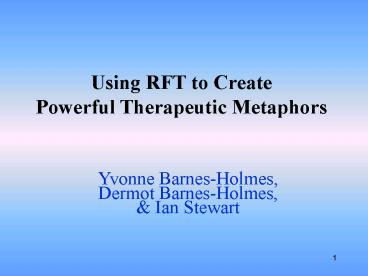Using RFT to Create - PowerPoint PPT Presentation
1 / 17
Title:
Using RFT to Create
Description:
Drowning. CAUSAL. RELATION. Struggle. with anxiety. Panic attack ... ACTUAL drowning. CAUSAL. RELATION. CAUSAL. RELATION. Arbitrary Crel for Co-ordination ' ... – PowerPoint PPT presentation
Number of Views:28
Avg rating:3.0/5.0
Title: Using RFT to Create
1
Using RFT to Create Powerful Therapeutic
Metaphors
Yvonne Barnes-Holmes, Dermot Barnes-Holmes,
Ian Stewart
2
Workshop Overview
- The current workshop consists of three parts
- Overview of the RFT account of analogy and
metaphor - De-construction of examples of ACT metaphors
- Construction of novel metaphors for clinical
practice
3
Understanding Analogy Metaphor
- Relational frame theorists have employed the
concept of relating relations, as the basic
process underlying the verbal abilities for
understanding and constructing analogies and
metaphors - At its most basic, Barnes, Hegarty, and Smeets
(1997) proposed a model of analogical reasoning
that involved responding in accordance with
equivalence-equivalence relations (i.e. the
relating together of derived equivalence
relations)
4
APPLE
DOG
Equivalence-Equivalence
Equivalent
Equivalent
SHEEP
PEACH
5
Is that it?
- The previous example involved the derivation of
arbitrary stimulus relations - But analogies and metaphors also appear to
abstract out non-arbitrary relations among events - Consider the analogy Apple is to Peach as Dog is
to Sheep - This abstracts out specific non-arbitrary
properties that pertain to each of the two sets
of relations
6
Crels Round, juicy, edible
Crels Hairy, four legs,
lives in groups
The analogy then also allows two sets of
non-arbitrary properties to function as Crels for
the two equivalence relations
7
Understanding Analogy Metaphor
- So, two of the central features of the RFT
theoretical and empirical model of analogy and
metaphor are - Relations between derived arbitrary relations
- Relating based on the abstraction of
non-arbitrary properties
8
Understanding Analogy Metaphor
- Because the relating of the derived relations
most often involves a relation of coordination,
it is common that individuals experience this as
a novel insight or Aha! - And this of course, may be based on the fact
that the two related events give rise to similar
somatic outcomes, such as the same feeling
9
Understanding Analogy Metaphor
- However, it is errroneous to think of
analogies/metaphors as simply the compounding of
one or two relations of coordination, especially
when the metaphors in question are used for
clinical purposes - Instead, these are substantive relational
networks, that require sophisticated verbal
histories of shared knowledge and experience - Take a look at this . . .
10
(No Transcript)
11
Understanding Analogy Metaphor
- Of course, metaphors are practically useless for
clinical purposes if they fail to facilitate
behaviour change - And thus some specific transformations of
function must be targeted with the relational
networks and in such a way that they make the
behaviour change seem feasible
12
(No Transcript)
13
Secrets for Constructing Good Clinical Metaphors
- Try to unhinge yourself from the verbal traps
and frustration if you are finding a metaphor for
a problem that you have been struggling with for
some time - You could maybe even think of a metaphor that
would describe yourself in this situation!
14
Secrets for Constructing Good Clinical Metaphors
- Try to think in precise and simplistic terms
about the clients - existing relational network (think of this as the
target) - the types of relations contained therein
- the transformations of functions that currently
occur - If it helps, even draw them out in order to try
to illucidate target non-arbitrary properties - The closer your vehicle (i.e. the other network
you construct with the metaphor) matches the
target relationally, the better will be your
metaphor
15
Secrets for Constructing Good Clinical Metaphors
- Once you have the target network in mind, try to
think through the non-arbitrary features of this - And then identify what happens to the client when
she experiences these properties - Often, the properties are coordinated with
evaluations like stupid, disgusting, hopeless and
these participate in self-relations (and thats
why she feels so bad about herself) and she
desperately wants you to share in these (i.e.
co-ordination relations in the perspective-taking
frames)
16
Trying to Find Solutions is Like Digging in a
Hole
Feelings generated by target network Repetitive
Feels painful Overwhelming
Feelings generated by the vehicle Getting
deeper Dark Helpless . . .???
Finding solutions
Dig in hole
SAME
Getting confused
Sinking
In this case, the vehicle enhances aspects of the
properties associated with the target
17
Secrets for Constructing Good Clinical Metaphors
- Networks
- Specific relations
- Non-arbitrary properties
- Behaviour change

